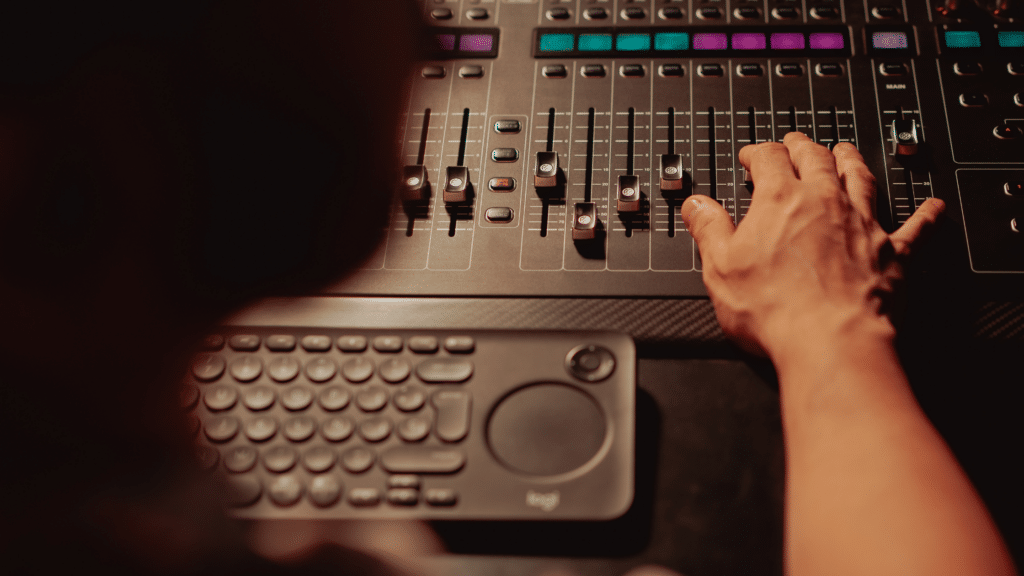The best teachers turn their passions into lessons, and we recently met someone who has done just that—bringing extraordinary passion and excitement to their teaching, even outside of the traditional classroom. Amazing educator and audio wizard, Darren Mccrae, gives us a look inside audio-video production, how filmmakers use sound to manipulate our emotions and immerse us into their cinematic worlds, and how binaural recordings are changing the way we experience audio.
From car stereos to filmmaking

We met Darren at TCEA in February and couldn’t help but be rapt by his extensive knowledge of audio, which makes perfect sense once we found out that he is an Audio-Video Production teacher (also known as Digital Communications). As part of his role as an educator at Monahans High School in west Texas, he helps run the Stream Team—a group of students that stream the school’s football games and live events like graduation.
While Darren educates the next generation of AV enthusiasts, his own love for all things audio started at a very early age. As an avid music listener, he gained a natural interest in car stereos and spent much of his high school years installing car stereo systems, trying to achieve the best sound through his subwoofers.
By the time he landed in college, Darren’s newfound love of acting collided with his audio background and films became his new passion. “Once I started with film and really became immersed, I realized how big a part of a movie sound is,” explains Darren, “So my love for audio carried over from car stereos to filmmaking.”
Cinematic sound—the secret manipulator
In his opinion, filmmaking is the ultimate manipulation or emotional manipulation to be precise. “Throughout history, film has been used for both good and bad manipulation,” Darren points out. A key example of bad manipulation is propaganda. As defined, propaganda is a tool that has been used throughout history to promote or publicize a particular political cause or point of view but in a biased or misleading way so as to manipulate the audience.
“On the other side,” notes Darren, “When filmmaking is purely for entertainment, the use of emotional manipulation is part of the cinematic experience and there is more room to be creative. That’s when we can have fun with it.”
One of Darren’s inspirations, well-known filmmaker, George Lucas, has a famous quote that says “Sound is 50 percent of the moviegoing experience” meaning that a lot of the emotional manipulation that is created through film comes from the audio going on in the background, toying with our subconscious.
“A lot of times we don’t fully think about the sound coming from behind us in a movie theater,” says Darren, “You hear it, it draws you in, and good filmmaking does that to you. It creates a world that you live in. You don’t necessarily recognize the mechanics happening around or to you, you’re just in them.”
In his classroom, Darren teaches his students all the tips and tricks that go into cinematic sound to create immersive experiences. For instance, a popular trick among horror filmmakers is to utilize a low-frequency response.
Ever get that unnerving feeling during a suspenseful part of a scary movie? It’s not just the dark and eerie imagery on screen, it’s also the infrasounds—meaning the sound lowers to a frequency that the human ear can’t hear, but instead we feel it.
Darren explains, “When you get those deep bass tones down around 20 Hertz, your brain and your body are aware of it, but you’re not actively hearing anything and in turn, it makes you uncomfortable.” Darren continues, “Horror movies use infrasounds very effectively, as well do many action and superhero movies during explosions and fight scenes for example.”

Another tip Darren passes along to his students is the use of ambient sounds—all those tiny audio details you may not even realize are present, but they put us right there in the scene. “It’s a way of world-building,” imparts Darren, “When you’re watching a film and the scene is in a park, you hear birds chirping or the wind through the leaves—A lot of people don’t realize that that is the work of sound engineers. The background noise is just as important as the spoken lines to build a scene.”
To drive home the importance of sound in cinema, Darren acclaims Making Waves: The Art of Cinematic Sound, a 2019 documentary he has played for his class every year since its debut. The documentary is an homage to sound design in American cinema, exploring not only the history, but the emotional power sound can hold over us, as well as how much sound engineering has evolved.
Audio experiences in the Headphone Age
In the digital age, the possibilities for listening to audio are pretty much endless and this is also true when it comes to recording audio. A prime example of the latter is binaural recording—a way to create audio experiences, much like a movie without the visuals.
This type of recording uses two microphones, ideally about ears width apart facing away from each other (just like your own ears). This creates a 3-D stereo sound experience that makes you feel like you’re in the room with the performers or instruments.
“If ever there was a time for binaural recording and listening, it’s now because we’re in the Headphone Age,” says Darren, “Binaural recording is made for listening through headphones and this type of recording is the only way to truly reproduce sound as it’s happening around us.”
Darren recommends QSoundLab’s Virtual Barber Shop (1996) as a notable example of binaural recording and just recently, Darren and his students created their own binaural recordings that you can listen to on YouTube here.
A look inside audio-video production
Sound is an often overlooked part of the filmmaking process because people aren’t always aware of what aspect of it is making an impact on them. Thanks to Darren, we know even more about the importance of sound in filmmaking and how it helps create experiences. The next time you’re watching a movie, pay attention to the audio and remember—it’s more than just background noise.
